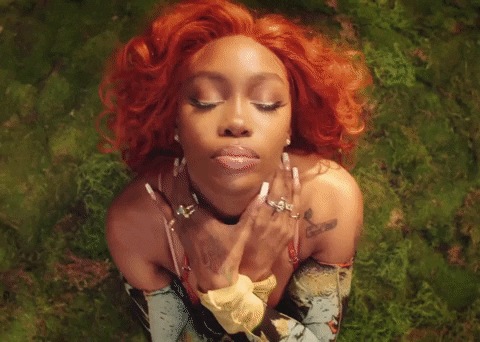
You’re reading Part 2 of THE BLUES LIVES THROUGH — my new essay collection linking past and present music. The classic Blues singers Ma Rainey and Bessie Smith rose to stardom in the 1920s. 100 years later, I write about Black singers preserving the Blues storytelling traditions in the 2020s.
This collection has six (6) parts. I will be unlocking a new part each week and emailing to free subscribers on the dates below. Paid subscribers have access now. I suggest reading them in this order:
Time Travel Via The Blues (1/30)
SZA’s SOS: Heartbreak & Healing Blues (1/31)
Are the Blues forever? (2/27)
This took four months of reading, writing and fact-checking and is entirely self-funded and self-produced by me. So I’m glad it’s finally here, especially with Black History Month and Women’s History Month upon us. I can’t wait to hear your thoughts. Lastly, here is a YouTube playlist with all the songs mentioned in this series.
SZA’s SOS
Heartbreak & Healing Blues
“It's so embarrassing. All of the love I seek living inside of me I can't see, I'm blind.” — SZA, “Blind” (2022)
The classic Blues women would find Solána’s impassioned, frustrating tales of acceptance, abandonment, and deliverance relatable —from her Soundcloud era to her present Top 40 days. The Grammy Award-winning SZA’s rise has been marked by hit singles, features, and songwriting successes, having penned for Beyoncé and Rihanna. Legendary songwriter and producer Babyface called her genius.
SZA’s accolades and co-signs are deserved because she’s proven she can write great songs about almost anything, but she’s infamous for using her pen to work through heartbreak. “People think I'm just like a sad girl or something all the time and I'm not,” she told Variety in November 2023. “It's just that's the part that I be writing about so I can not be a sad girl, so I can process my emotions and move forward.” The way SZA speaks on her music parallels a quote from Sippie Wallace, a popular 1920s singer and songwriter known as the Texas Nightingale. "I sing the Blues to comfort me on.... Most all my [Blues] is about myself."
Though I’m uncertain of how much SZA played the Blues for inspiration, the presence of it is ubiquitous in her story. The singer was raised in Maplewood, New Jersey, but her people are from St. Louis, a city with such rich Blues history, it inspired one of the earliest and most popular Blues recordings — W.C. Handy’s “Saint Louis Blues” (1914). The city’s NHL team is named after this song and she rocks this jersey on the cover of SOS. A fan can make many presumptions about this specific wardrobe choice. Is this SZA’s way of remembering her birthplace and St. Louis ancestors? Or is it perhaps a signal that she would be delivering her own version of the St. Louis Blues? She has reason to. In recent years, SZA mourned her late grandmother, who she would often visit in St. Louis. Her matriarch’s wisdom was a guide as she dealt with 20-something angst on her debut CTRL (2017).
In December 2022, SZA returned with the aptly titled SOS, a Morse code created for maritime use to signal distress. In SZA’s case, it was a sign she would be doing more inner work. The album cover is consistent with this message as it references an image of Princess Diana sitting alone on a diving board, a scene SZA felt perfectly represented isolation. Throughout the 23-track project, she sounds as if she’s alone with her thoughts and shedding the most unpleasant and honest ones over a nocturnal fusion of R&B, pop, synths, boom bap, and trap. It’s hard to place her in one genre and that’s because her long list of inspirations for SOS comes from many genres and are the best storytellers in music: Björk, Stevie Wonder, Ella Fitzgerald, Brandy, Joni Mitchell, Jay-Z, and others. She came out of the studio with the epitome of melancholy alternative music popular with millennial and Gen Z fans. The cool nature of her instrumentals balances her fiery diary-like lyrics she performs with her signature “cursive” wails and melodic raps. The singer also doesn’t leave us without showcasing her softer side with songs like the love confessional “Snooze” and “Conceited,” a carefree bop to hype herself up in the face of haters.
SZA’s naysayers say “she needs therapy” for her raw and sometimes extreme takes. But I hear SZA doing what the Blues women and men did 100 years before her — using sarcasm, irony, satire, and exaggerated storytelling as tools to get the listeners attention and feeling something. The album is therapy for fans because SZA evokes the real work of the Blues, which was to break down the walls of what feelings and thoughts we should keep private versus public in music. In doing so, she and many singers before her make the intimate and messy details of our lives something we grapple with as a community instead of in isolation. 1
This cultural confrontation is at play on her first no. 1 Billboard Hot 100 hit, “Kill Bill,” based on the 2003 Quentin Tarantino film — she’s known for sprinkling pop culture references throughout her work. The plot is straightforward: SZA plays an obsessive lover who wants to murder her ex and his new girlfriend and does so by the end of the track. Throughout the song, she contends it’s “not the best idea” and sarcastically tells herself, “I’m so mature” for meditating on carrying out this act. The action-packed music video offers more to the story. After her boyfriend breaks up with SZA, a group of hitmen he hired opens fire on the trailer the couple shared. SZA survives the attempted murder and seeks revenge. No one should condone violence in relationships as there are enough real-life, love, and murder stories that can make listening to “Kill Bill” triggering. For these reasons, SZA might have second-guessed putting it out, but decided the world needed another hyperbolic tragic love song. There is a long history of them.
SZA — “Kill Bill” (2022)
I might kill my ex, not the best idea/
His new girlfriend's next, how'd I get here?/
I might kill my ex, I still love him though/
Rather be in jail than alone.
Blues women "Ma" Rainey and Bessie Smith sang of women who chose violence against unfaithful or abusive men instead of resorting to despair.2 We hear it on Rainey’s “See See Rider,” a Blues standard recorded in 1924. The song concludes similarly to “Kill Bill.” Bessie Smith confesses to the same sin on “Sing Sing Prison Blues.”
Gertrude "Ma" Rainey — “See See Rider” (1924)
I'm gonna buy me a pistol,
Just as long as I am tall.
Lawd, lawd, lawd.
Gonna kill my man and,
Catch the Cannonball.
If he don't have me,
He won't have no gal at all.
“Sing Sing Prison Blues” — Bessie Smith (1924)
You can send me up the river
or send me to that mean old jail
I killed my man and I don’t need no bail.
These records remind us Black women’s humanity has complexities. Though we are increasingly the victims of gender and racial violence, we can also be perpetrators or complicit in harm. That violence can result from self-defense.3 In the case of the Blues, these singers challenged “the imposition of gender-based inferiority,” Angela Davis writes in Blues Legacies and Black Feminism. “When she paints Blues portraits of tough women, she offers psychic defenses and interrupts and discredits the routine internalization of male dominance.” These stories also hold up a mirror to society’s psychological and emotional well-being. The fact that fans gravitate towards this music in the past and present suggests many carry these repressed dark emotions concerning relationships. They may not say it out loud or want to act on it, but they need to release it. The saddest music gets attention because it has always helped people work through difficult suppressed emotions, and it’ll always be needed especially since good therapy isn’t cheap or easy to find.
SOS is not a harrowing listen in its entirety. SZA needs “Good Days” too. On the hopeful single, released December 2020, SZA is getting on with life after an emotionally rocky period. I chose Rainey’s “Lucky Rock Blues,” written by Katie Winters and Lovie Austin, as its Blues companion. To shake off the Blues, SZA calls on nature via shrooms in the accompanying self-directed music video, while Rainey yearns through travel and the supernatural. Similarly, Smith sings of leaving the harsh Northern city life to return to her Southern roots, as the lifestyle wasn’t the promised land she had expected. African Americans left the South in droves during the Great Migration to escape Jim Crow conditions, but up North, they faced an alternate manifestation of the same discrimination.
SZA — “Good Days” (2020)
All the while, I'll await my armored fate with a smile
Still wanna try, still believe in (good days, good days on my mind)
Good days (good days on my mind)
Always sunny inside (always in my mind, always in my mind, mind)
Good day living in my mind
Gotta get right, tryna free my mind before the end of the world...
Ma Rainey’s — “Lucky Rock Blues” (1924)
Goin’ to New Orleans to find that lucky rock
Goin’ to New Orleans to find that lucky rock
Tryin’ to rid myself of this bad luck I’ve got
On my way to find that lucky rock
Oh, I’m on my way to find that lucky rock
Just to ease my mind of all this trouble I’ve got.
Bessie Smith — “Far Away Blues” (1923)
Gonna keep on trampin’ ’til I get on solid ground
On my way to Dixie, Lord, I’m Lou’siana bound
…
Got a low down feelin’, I can’t lose my heavy load
My home ain’t up North, it’s further down the road.
SZA exists 100 years apart from Rainey and Smith, yet both eras of singers speak a timeless message that resonates with many: your emotional past does not have to dictate your future. Yes, it’s easy to celebrate someone who has already healed. But these songs recognize how brave it is to take those gentle steps forward while your heart is still heavy, eyes filled with tears, and the future is fuzzy — even if it means going alone for awhile.
Though many Blues lyrics exhibited heart-rending emotions, finding peace is something that all Black women deserve then and still do now. Since the 1920s, it’s beautiful to hear how Black women and non-binary people have authored more joyful and uplifting songs, which came with the realization that self-preservation and kindness to self and each other is the only way to freedom.
Continue reading part three “Janelle Monáe’s Age Of Pleasure: Sensual & Free Blues” here.
“The Blues had a lot of sarcasm, humor, satire and irony in order to make the most scathing critiques. Some mistaken that as women being unconscious of the mistreatment towards them. Naming issues that pose a threat to the physical or psychological well-being of the individual is a central function of the Blues. Indeed, the musical genre is called the “Blues” not only because it employs a musical scale containing “blue notes” but also because it names, in myriad ways, the social and psychic afflictions and aspirations of African Americans. The Blues preserve and transform the West African philosophical centrality of the naming process. In the Dogon, Yoruba, and other West African cultural traditions, the process of nommo—naming things, forces, and modes—is a means of establishing magical (or, in the case of the Blues, aesthetic) control over the object of the naming process.89 Through the Blues, menacing problems are ferreted out from the isolated individual experience and restructured as problems shared by the community. As shared problems, threats can be met and addressed within a public and collective context.”
Davis, Angela Y.. Blues Legacies and Black Feminism: Gertrude Ma Rainey, Bessie Smith, and Billie Holiday (p. 33). Knopf Doubleday Publishing Group. Kindle Edition.
ibid (pp. 20-21).
Harrison, Professor Daphne. Black Pearls: Blues Queens of the 1920s. Chapter 3, Kindle Edition.





